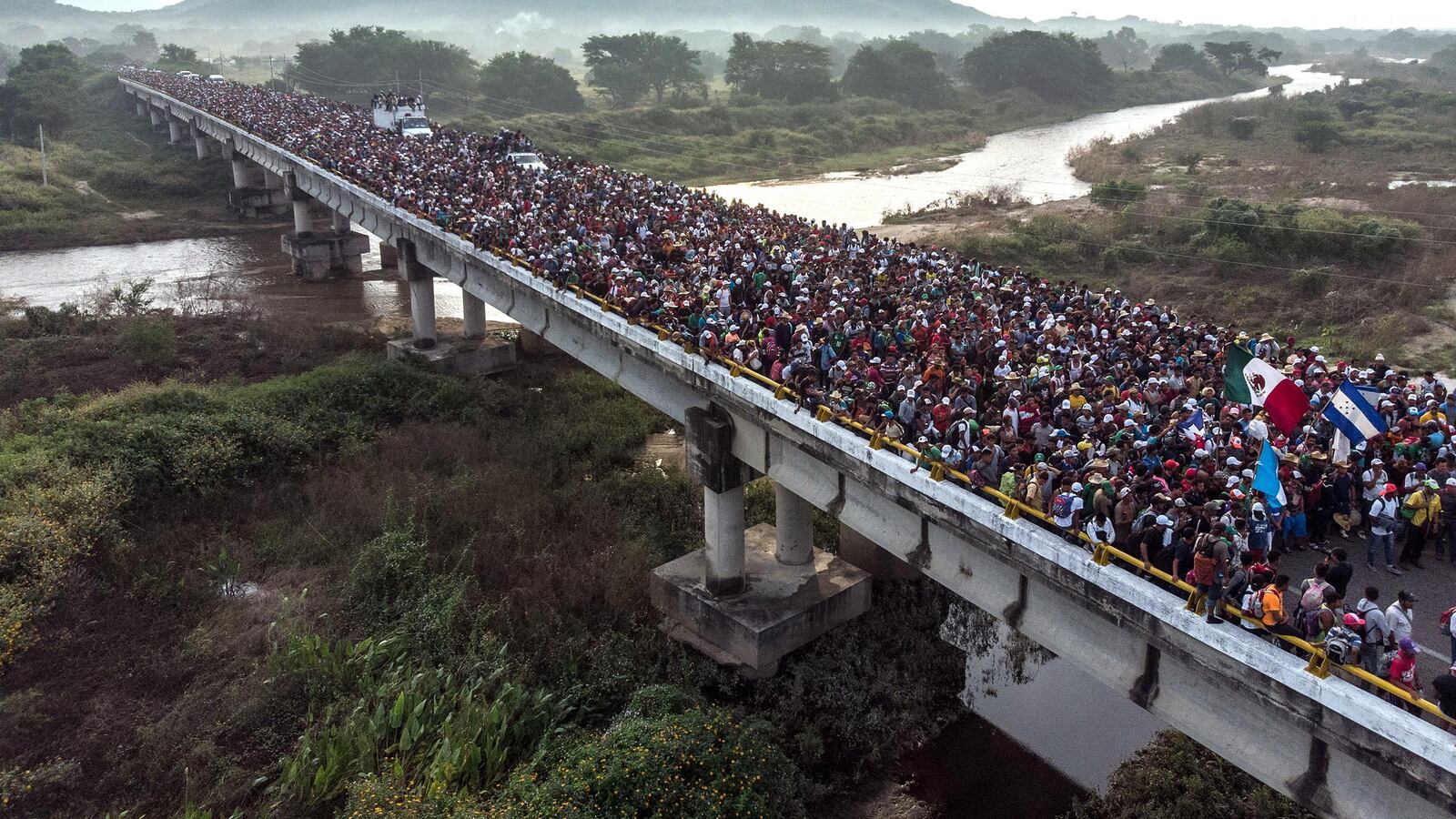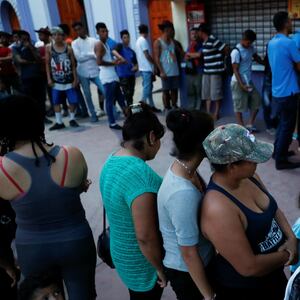SAN PEDRO TAPANATEPEC, Mexico—A brawl broke out, and in a split-second the momentum that had carried the thousands-strong migrant caravan from Honduras to Guatemala and Mexico, marching for 22 days over 1,000 kilometers, was nearly brought to an end.
The marchers here had only a vague sense of the hysteria that U.S. President Donald Trump has tried to generate about them, and continues to fuel. On Monday morning, Trump tweeted a fearmongering message claiming that, “Many Gang Members and some very bad people are mixed into the Caravan heading to our Southern Border.” He told them to turn back. He claimed that the caravan—still thousands of kilometers and many weeks away from the U.S.—“is an invasion of our Country and our Military is waiting for you!” And then news broke that Trump would be sending 5,200 regular U.S. Army troops to the Mexican border, more than 2.5 times the number fighting the so-called Islamic State in Syria.
All this after a white nationalist inspired by the caravan hysteria and the conspiracy theory that the march is a Jewish plot to, yes, invade the U.S., allegedly opened fire with an assault rifle in a Pittsburgh synagogue and slaughtered 11 people.
That extraordinary North American madness seems very distant here, but the little brawl on Saturday showed just how fragile the situation really is among a flock of people who sense all sorts of wolves circling them: traffickers, activists with their own agendas, corrupt cops, all of them ready to exploit their exhaustion, fear, frustration, and depression.
WHEN THE MARCHERS reached San Pedro Tapanatepec on Saturday, they went about their routine, resting up and then getting ready for the daily departure at 3 a.m. on Sunday in the cool before dawn, on their way to the next stop. But on Saturday night, rumors of a child disappearing set off a wave of fury. The circumstances were and remain murky, some people thought the rumor and the reaction might be the work of provocateurs, but in any case the reaction was angry and a young man was beaten up before the intervention of a volunteer doctor brought people back to their senses.
Later in the evening, word spread that the customary 3 a.m. departure was canceled and everyone would stay put for a “much needed day of rest” on Sunday. The crucial momentum hung in the balance as people hunkered down that morning as best they could to avoid the heat of the sun. The town square was carpeted with little makeshift settlements of people huddling under tarps. Others sat or slept on the sidewalks, sheltering along the sides of buildings as if in trenches made of shade. It seemed the march might be over.
People had heard as they approached San Pedro Tapanatepec that Mexico’s lame duck president, Enrique Peña Nieto, had pulled a fast one, announcing a plan called “This is your home” on a video distributed to national media. It offered migrants a temporary ID card, education for their children, health care and temporary jobs so long as they all registered with Mexico’s Institute of Migration and began the process of resolving their migratory status. All on one condition: that they remain in the southern provinces of Chiapas and Oaxaca. Free to come and go within those boundaries. Refugees on hold.
This after Mexico had promised safe passage. Now that assurance was gone. The whole thing looked like a capitulation to Trump on the one hand, and a very unreliable promise on the other.
Then, by Sunday afternoon, the marchers had taken things into their own hands. Allan Javier Osorio, who worked as an electrician in Honduras, sat under a tarp surrounded by a group of anxious men and women who were talking about the caravan’s image having been irreparably tarnished by the incident the night before. “Those that caused the brawl are infiltrators. They are trying to give us a bad name,” he said, adding, “The world is watching us and we know that any little incident can send us to the wolves.”
Osorio said that the migrants had met in an informal assembly to resolve how to avoid any future incidents. “We voted on creating our own monitoring group of 300 migrants—not just to monitor, but also function as kind of crowd control.” Asked about who really held the reins of the marchers, Osorio said, “We have been together from the beginning. No one tells us what to do. We have organized, developed our base, among us.” So no one from outside, including a plethora of groups like Pueblo Sin Fronteras (People Without Borders) is really leading the march? The answer was categorical. “No.”
People Without Borders, a San Francisco-based activist organization that claims it has run similar but smaller migrant “caravans” for the past 15 years, has presented itself as the ad hoc “organizer” of the current caravan, producing press releases on the marchers’ behalf and acting as the caravan’s go-between with the government. Osorio told The Daily Beast that the migrants’ response to the “This is your home” plan was to reject it unanimously and that word had been relayed to the government by People Without Borders. But then he added emphatically, “WE are the people without borders.”
“We’re continuing with our plan. We have our own base and we’ve all discussed it. There is no other plan,” Osorio said: straight to Mexico City and the U.S border. End of story. On Sunday afternoon this renewed determination was on full display, and not just in his group, but echoed all over. “We’re decided!” said Diana Christina Perez, a young mother, “Nothing’s going to stop us.”
“President Peña Nieto’s response comes a little too late,” Mauricio Rafah told The Daily Beast. Farah served as the president’s congressional administrator until last week when he resigned from the outgoing administration. He is also an expert on migrants’ rights.
“There will be a majority that will continue to the U.S.,” said Rafah, but he noted they will be at greater risks of kidnapping, extortion, and violence from human traffickers, drug traffickers and the notorious gangs that govern the northern part of Mexico. Those migrants who have been in this massive flock, protected by numbers, will move into the shadows, spread out, and pretty much on their own.
Among the other groups that have been present throughout the caravan’s journey is Mexico’s National Commission for Human Rights. Edgar Corzo, oversees its migrants human rights office. Corzo told The Daily Beast the Mexican Federal Police had carried out a round-up operation of 300 migrants, detaining 150. Corzo said, “We followed up with those detained to check on whether there had been abuses, No one came forward.”
THE MIGRANTS KNOW in a general sense that the president of the United States is portraying them as criminals, thieves, gang members—basically the scum of the earth. But still they want to go to the U.S.
José Castellanos was candid. “Our own countries in Central America treat their migrants like dogs,” he said, recounting his own experience several years back with Mexican Immigration authorities. “I had witnessed gangs murder two people. They told me they were coming to kill me and my family.” They fled to Mexico asking for asylum. The Mexican immigration authorities detained us for 90 days then basically threw us out on the Honduran border, worse than dogs.”
By late Sunday afternoon, the earlier tattered patchwork of confounded migrants lingering in the square turned into a jubilee of relief and renewed determination. The caravan’s own plan was in full display. Two large buses arrived in the crowded square to distribute food from “Las Señoras de la Dulceria de Puchitan,” meaning “the Ladies of the Pastry Shop of Puchitan.” In a flash, they were surrounded by the migrants in the square. Immediately a man took a microphone and ordered all of them to form into three single file lines: Women and children, elderly, and young men. And they did, obediently.
Sunday evening, it was announced the caravan would be leaving at 3 a.m. towards the village of Santiago Niltepec, 50 kilometers further up the road.
“It is a historic moment in Central American history,” said Castellanos. “There’s never been a demonstration on this scale.” He paused. “Maybe, he said, “all our stories will finally get the American public, and the world, to understand who we are. That all we want is to create a better life for our children.”
At 3 a.m the first marchers started on the Carretera Internacional, but it seemed at first that there were far fewer than before. The first group sat down on the pavement despite the Federal Police asking them to move on. No one budged. They were waiting for the next group, and the next group, and then, like an accordeon that compressed and expanded, the caravan lined the side of the highway for miles on miles.
The march continued. By Monday evening they were crowding into Santiago Niltepec. The momentum was back.







